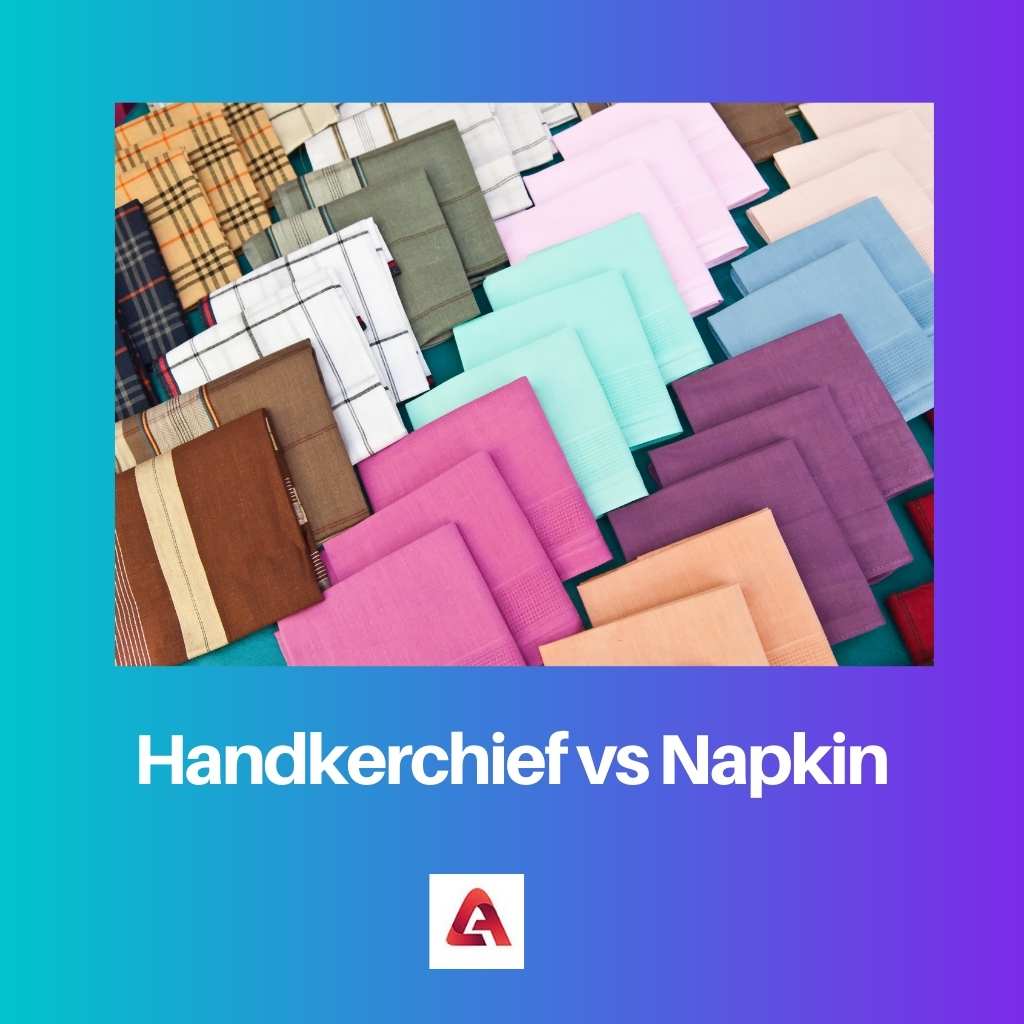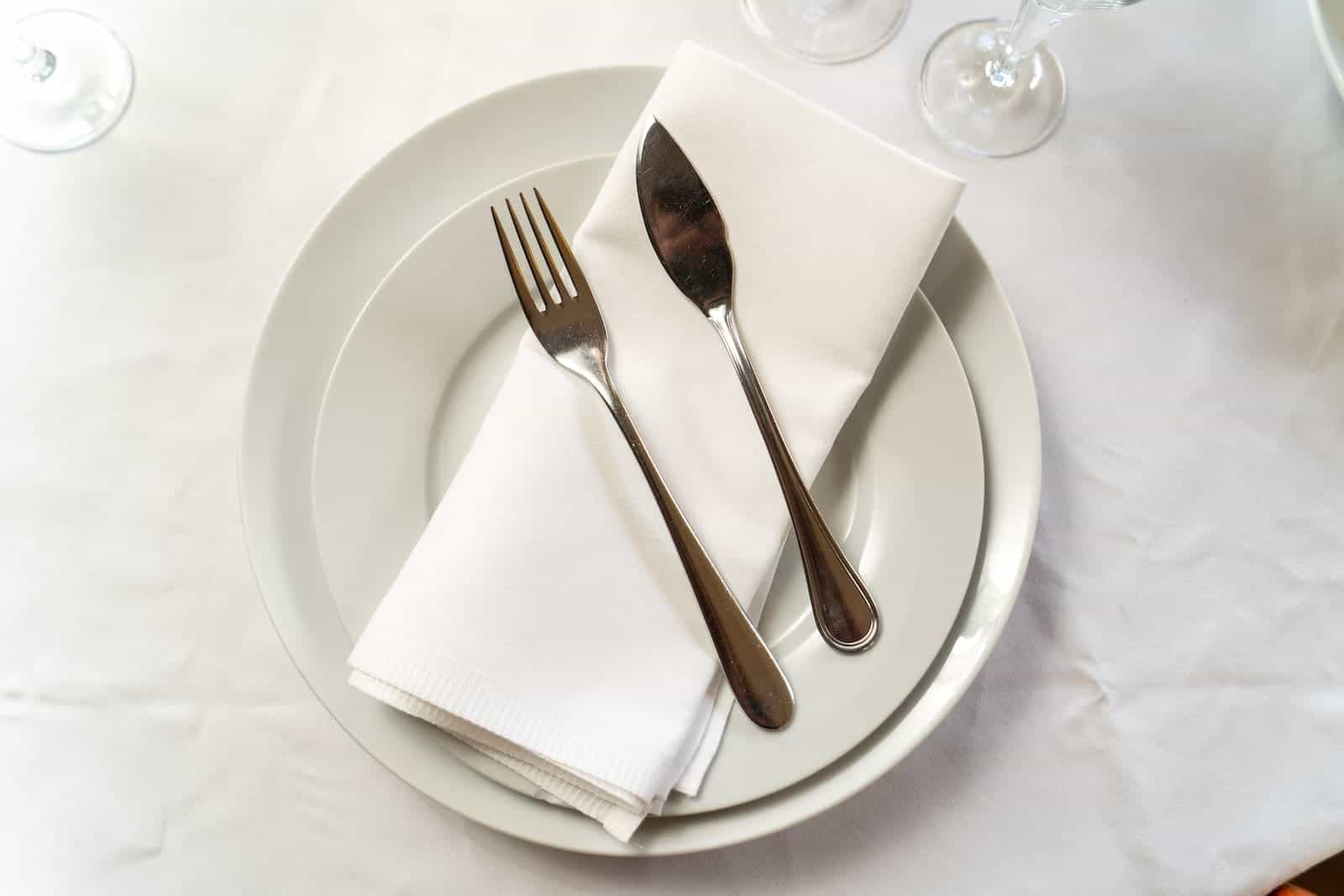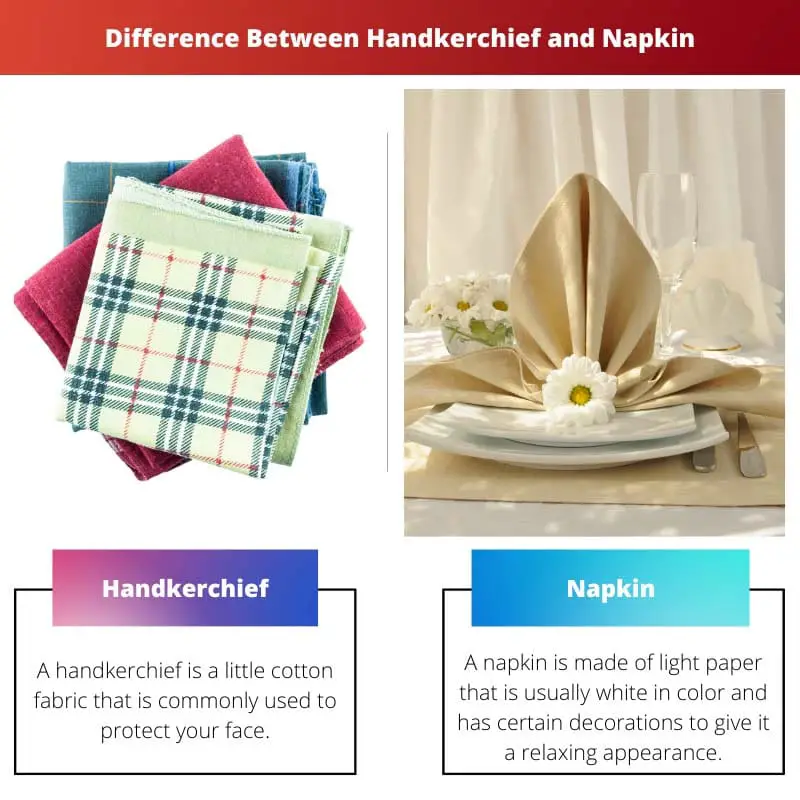We’ve figured out how to turn natural materials into usable, daily products over time. Fabrics are an illustration of this.
Cotton is used to manufacture handkerchiefs, and paper is used to make napkins, both of which are daily necessities.
This is done to guarantee that there are no grease or food particles left in our mouths or hands, which could damage our clothing and appearance.
Key Takeaways
- Handkerchiefs are small, square pieces of fabric used for personal hygiene, carried in pockets or purses, while napkins are table linens for wiping the mouth and hands during meals.
- Handkerchiefs are reusable and made of cotton or silk, whereas napkins can be disposable or reusable and come in various materials, such as paper or cloth.
- Handkerchiefs have a more decorative and personal nature, with intricate designs or embroidery, while napkins are simpler and designed for practical use during dining.
Handkerchief vs Napkin
A handkerchief is a small square shaped cloth made of cotton or linen, created to be used for personal hygiene, such as wiping the face. A napkin is a large piece of fabric made of cloth or a type of paper. A napkin is created to be used during meals to wipe or clean the mouth and hands.

A handkerchief is a little cotton fabric that is commonly used to protect your face. There are also other types of handkerchiefs available, such as a flannel.
A hanky is a little piece of fabric that can be used to replace paper tissues in common situations. It’s normally made up of a single layer of fabric, although it can be made in larger sizes or even doubled for greater absorbency.
A napkin is made of light paper that is white in color and has certain decorations to give it a relaxing appearance. In most restaurants and culinary establishments, napkins are kept on one side of the table.
People carry napkins after eating or while dining to prevent food from spilling on their clothes.
Comparison Table
| Parameters of Comparison | Handkerchief | Napkin |
|---|---|---|
| Material | Cotton and linen | Paper |
| Re-usable | Can be re-used | Cannot be re-used after the first usage |
| Durability | More durable | Less durable, they can tear easily |
| Hygiene | Less hygienic as they are used over and over | More hygienic as they are for one-time use only |
| Uses | Cleaning hands, covering the face for heat/dust protection, stop bleeding, ice pack cloth, blindfold | Can be used only for personal hygiene |
What is Handkerchief?
A handkerchief is a folded piece of thin fabric that can be carried in one’s pocket or pocketbook for personal grooming purposes.
Handkerchiefs are used in a variety of folk performances around the world, including the Balkans and the Middle East; Kalamatianos is one such ancient dance.
Since the late 18th century, white hankies have been waved at public gatherings, primarily by females (men traditionally waved their hats).
Both West African and African-American traditional dance incorporates the usage of handkerchiefs to emphasize hand movements while dancing, particularly during wedding rites in the latter case.
In various styles of English folk dance, handkerchiefs are also common accessories.
In addition to their intended use, they can be used as a sweatband, hot cooking utensil holder, polishing shoes, signaling for help, neckerchief, Molotov cocktail wick (fire-bomb), dust protection, to repair footwear,
cleaning hands and face, a makeshift bandage, tourniquet, or arm sling.
The word kerchief was widely used before the word handkerchief was coined. This name is derived from two French words: couvrir and chef.
Handkerchiefs were commonly used in ancient Greece and Rome, just as they are now. Kerchiefs, on the other hand, were commonly used to cover the head in the Middle Ages.

What is Napkin?
Napinks are quite common in use and in everyone’s day-to-day lives. The napkins are sold in packs of 50-100 and are always inexpensive to purchase.
They’re layered such that when one of them is taken out, the other is automatically drawn to half. Because of their short length and light design, the napkins cannot be folded into a pattern like the Serviette.
The small pressure applied to napkins causes them to tear, which is one of the reasons they are not appropriate for making artwork.
Napkins are made of fabric or cloth. People are becoming used to using napkins these days.
Napkins are kept near the table in restaurants and star hotels for wiping the face before and after meals. They also create lovely motifs, such as birds, which they embellish with colored napkins.
Typically, these napkins are utilized in casual dining circumstances. Large napkins are sometimes used at fancy events.
Embroidered napkins are also given as gifts for numerous occasions. These decorating customs can be seen in both Western and Eastern civilizations.
Customers are frequently drawn to the way napkins are arranged at restaurants, and they feel satisfied while eating. Napkins are draped over the neck while dining to keep food spills at bay.
A napkin is a rectangle or square piece of paper that we use at the table to wipe our mouths and fingers clean as we eat. It also protects the clothes you’re wearing from food stains, spills, and bits.
Napkins are arranged in many styles and shapes.
Because of their short length and light design, the napkins cannot be folded into a pattern like the Serviette. The small pressure applied to napkins causes them to tear,
which is one of the reasons they are not appropriate for making artwork.

Main Differences Between Handkerchief and Napkin
- Handkerchiefs are made of cotton, and napkins are made of paper.
- Handkerchiefs can be reused, and napkins cannot be reused.
- Handkerchiefs are more durable, and napkins are less durable.
- Handkerchiefs are less hygienic, and napkins are less hygienic.
- Handkerchiefs have various purposes like ice pack cloths and dust protection, but napkins can only be used for cleaning.

- https://www.researchgate.net/profile/Juraj-Gigac/publication/341829182_PREDICTION_OF_WATER-ABSORPTION_CAPACITY_AND_SURFACE_SOFTNESS_OF_TISSUE_PAPER_PRODUCTS_USING_PHOTOCLINOMETRY/links/5ed6674692851c9c5e72baea/PREDICTION-OF-WATER-ABSORPTION-CAPACITY-AND-SURFACE-SOFTNESS-OF-TISSUE-PAPER-PRODUCTS-USING-PHOTOCLINOMETRY.pdf
- https://books.google.com/books?hl=en&lr=&id=yj8QDgAAQBAJ&oi=fnd&pg=PA141&dq=handkerchief+and+napkin&ots=KjiAp2ZhmW&sig=9u8VIJQTSZBMsTzjLIjVggHFSv4



